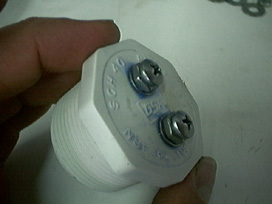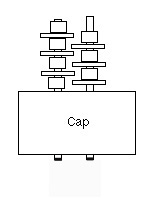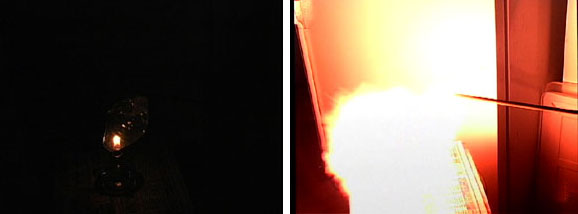|
|
|
|
|
|
|
|
|
|
|
|
|
|
|
|
|
|
|
|
|
|
|
|
|
|
|
|
|
The content on this web page is offered for informational purposes only! Please do not attempt to recreate the experiment shown here. New – Hydrogen- Oxygen Generator The Original Oxy-Hydrogen Generator |
|
|
|
|
||||||||
|
|
|
|
|
|
|
|
|
|
|
||||||||||
|
|
|
Oxy-Hydrogen gas is easy to make. Of course this gas is too dangerous to be of any practical use, but who wants to be practical ALL of the time? Please note that this gas is OXY-Hydrogen, and not pure hydrogen. Pure hydrogen can be stored safely, but Oxy-Hydrogen is HIGHLY EXPLOSIVE and CANNOT BE STORED SAFELY under any circumstances!! Don't try to store it!! In the above diagram, water is decomposed into its constituent elements, hydrogen and oxygen through a process known as electrolysis. The Oxy-Hydrogen generator is made from clear 1.5" diameter PVC pipe. The pipe is sealed on the top and bottom by pipe thread adapters and screw-on 1.25" PVC caps. The bottom cap has two stainless steel bolts with washers and nuts attached (see below). The top cap has a "barb fitting" which allows rubber surgical tubing to be attached. The gas flows to a second vessel which is filled with water and open at the top. A piece of copper tubing is attached to the surgical tubing and bent at the angles shown. It is VERY important that the oxy-hydrogen be discharged into water as shown to prevent a spark from igniting the mixture in the Oxy-Hydrogen generator. If the mixture in the generator were to ignite, it would rupture the PVC pipe, showering caustic solution everywhere. VERY BAD!! The Generator is filled halfway with a solution of potassium hydroxide and water. You must wear gloves and safety glasses when working with any caustic solutions, as they eat through skin and eyes! The potassium hydroxide acts as an electrolyte, permitting current to flow through the water. Potassium hyroxide is found in a few brands of drain cleaners, such as "Drain-Out". Most drain cleaners such as "Drain-O" contain Sodium Hypochlorite (chlorine bleach). DO NOT USE ANY CHEMICAL CONTAINING CHLORINE IN THIS SETUP! The objective is to make oxy-hydrogen gas, not chlorine gas. Check the label carefully before using it. "Red Devil" Lye does work, but it tends to deposit an undesirable brown scum in the generator. The best bet is to get some pure potassium hydroxide from a chemical supplier such as The Science Company and mix your own solution. Add 15 grams of potassium hydroxide to 1 liter of warm water. |
|
|
|
||||||||||||||
|
|
|
|
|
|
|
|
|
|
|||||||||||
|
|
|
The first step is outfitting the bottom cap for use. You must first get two 2.5" stainless steel bolts. We used 10-24 size bolts. Thread stainless steel nuts and washers on the bolts in the pattern shown above. Hold the bolts as close to each other without the washers touching, and record the distance between the two. Remove the washers and nuts from the bolts. Drill two holes in the cap (just smaller than the diameter of the bolts) with the same spacing that you measured between the bolts in the last step. Now you can screw the bolts into the drill holes in the bottom of the cap. Tapping the drill holes with the proper size tap makes this easier. Thread the bolts and washers on the bolts again as before. You should glue the bolts into place to prevent leaking. |
|
|
|||||||||||||||
|
|
|
|
|
|
|
|
|
|
|
|
|
||||||||
|
|
|
Now you can attach the cap to the PVC tube. We glued (1.5" pipe to 1.25" pipe thread) adapters on to both ends of the tube to make it easy to take the generator apart. We then screwed the caps on when the glue on the adapters was dry. The top cap is a 1.25" pipe thread adapter with a barb fitting adapter screwed into it. At this stage it is important to check for leaks. Fill the generator with water. With your thumb over the barb fitting hole, turn the unit upside down and look for drips. |
|
||||||||||||||||
|
|
|
|
|
|
|
|
|
|
|
|
|
||||||||
|
|
|
|
Here is the assembled unit shown with the surgical tubing attached and the copper tubing under water to prevent ignition within the generator itself. The power supply is a 12 volt DC, 25 amp radio shack power supply. A 12 volt battery charger, car battery, or 40+ watt solar panel can be used, also. Keep the Oxy-hydrogen away from any sparks which might happen when you attach or detach the wires! Please note that the power supply MUST be DC! AC will NOT work! Before turning on the device, make sure you have your safety glasses on! When you turn on the power supply, the Oxy-Hydrogen will start bubbling in the generator. For approximately a minute, the gas coming out of the copper tube will contain mostly residual air from the space in the generator and the surgical tubing itself. Do this in a well ventilated area, and NEVER WALK AWAY FROM THE GENERATOR WITH THE POWER TURNED ON. If this gas were to build up in an enclosed area, it could cause a nasty explosion. |
|
|||||||||||||||
|
|
|
|
|
|
|
||||||||||||||
|
|
|
|
After donning our earplugs and face shields, we attached a SMALL (deflated) sandwich bag to the end of the copper tube (with a rubber band) in the water tank. After it was full of Oxy-hydrogen, we attached it to a LONG stick and held it over a candle flame. Boom! As mentioned before, this gas is too dangerous to store or be of any practical use. For more information about how to build a large system to heat your house and provide electricity see "Solar Hydrogen Production by Electrolysis". |
|
|
||||||||||||||
|
|
|
|
|
|
|
|
|
|
|
|
|
|
|
|
|
|
|||





